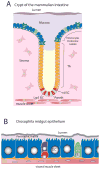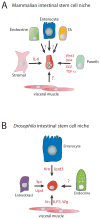Intestinal stem cell function in Drosophila and mice
- PMID: 22608824
- PMCID: PMC3426656
- DOI: 10.1016/j.gde.2012.04.002
Intestinal stem cell function in Drosophila and mice
Abstract
Epithelial cells of the digestive tracts of most animals are short-lived, and are constantly replenished by the progeny of long-lived, resident intestinal stem cells. Proper regulation of intestinal stem cell maintenance, proliferation and differentiation is critical for maintaining gut homeostasis. Here we review recent genetic studies of stem cell-mediated homeostatic growth in the Drosophila midgut and the mouse small intestine, highlighting similarities and differences in the mechanisms that control stem cell proliferation and differentiation.
Copyright © 2012 Elsevier Ltd. All rights reserved.
Figures


References
-
- Micchelli CA, Perrimon N. Evidence that stem cells reside in the adult drosophila midgut epithelium. Nature. 2006;439(7075):475–479. - PubMed
-
- Ohlstein B, Spradling A. The adult drosophila posterior midgut is maintained by pluripotent stem cells. Nature. 2006;439(7075):470–474. In these two papers [1, 2], the authors showed that the adult Drosophila midgut undergoes dynamic renewal mediated by intestinal stem cells, and that Notch signaling regulates stem cell self-renewal and differentiation. - PubMed
-
- Tian H, Biehs B, Warming S, Leong KG, Rangell L, Klein OD, de Sauvage FJ. A reserve stem cell population in small intestine renders lgr5-positive cells dispensable. Nature. 2011;478(7368):255–259. In these two papers [4, 5], the authors revealed the relationship between two intestinal stem cell pools, the Lgr5+ CBCs annd the Bmi+ +4 ISCs. While they are capable of giving rise to each other, the +4 stem cell pool are relatively quiescent and function as a reserve for active Lgr5+ CBCs. - PMC - PubMed
Publication types
MeSH terms
Grants and funding
LinkOut - more resources
Full Text Sources
Molecular Biology Databases

